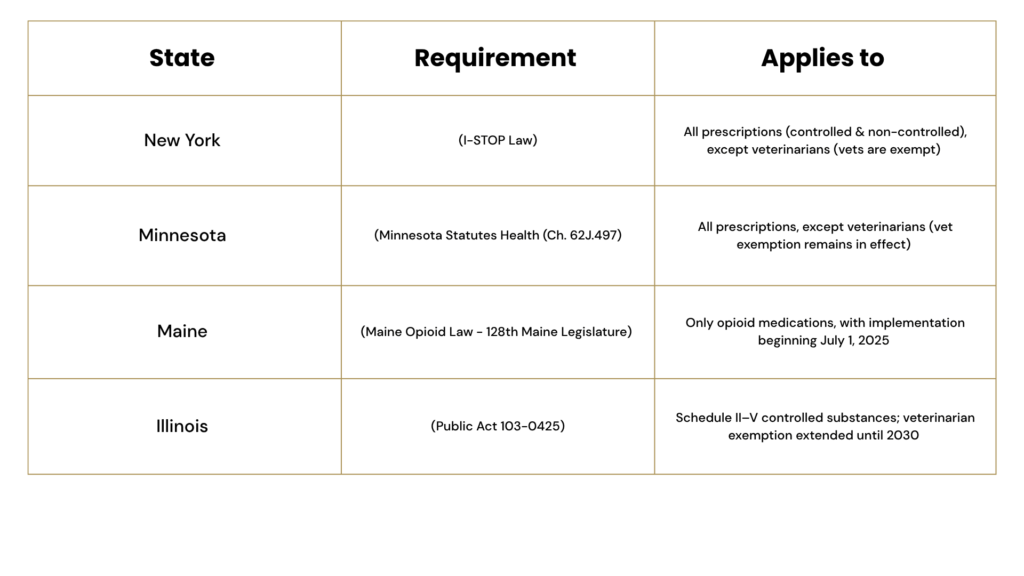The way many veterinary clinics handle prescriptions, especially controlled substances, simply isn’t holding up anymore. Paper scripts, call-in refills, sticky notes by the phone, these familiar processes were once good enough. But veterinary practices have evolved, and these older methods are starting to show their cracks.
Veterinarians are managing more complex cases, fielding tighter turnaround times, and navigating increasing scrutiny around controlled substances. In that context, the risks of sticking with outdated workflows begin to multiply. A misfiled note. A missed refill. A misunderstanding regarding dosage. These aren’t just operational hiccups. They’re points of vulnerability for patient safety and professional credibility.
That’s where Electronic Prescribing of Controlled Substances (EPCS) certified software becomes indispensable. It brings structure and security to an area that can no longer rely on manual systems or informal shortcuts. Think of it as upgrading from a handwritten ledger to a modern, automated accounting system. But unlike general digital tools, EPCS certified software is purpose-built for managing the prescription of controlled substances with the accuracy, traceability, and safeguards today’s practices require.
With EPCS functionality integrated into a veterinary EHR, clinicians can manage prescriptions with the same confidence they bring to a diagnosis. Every order is backed by clear authentication, audit trails, and built-in protections that help eliminate ambiguity. This isn’t just about efficiency; it’s about ensuring that prescribing workflows support both clinical excellence and legal accountability.
And this shift isn’t just about a compliance check box. It’s about keeping pace with the realities of modern practice. Pet ownership is rising, client expectations are evolving, and clinic schedules are tighter. A veterinarian juggling back-to-back appointments doesn’t have time to play phone tag with a pharmacy. EPCS certified software reduces that friction and frees up time for what really matters: delivering care.
The broader industry is already heading in this direction. The global veterinary EHR market is projected to reach $1.37 billion by 2030. That kind of growth reflects more than regulation. It reflects a demand for digital infrastructure that supports safe, accountable, and future-ready clinical operations.
For software developers, this moment represents a strategic inflection point. EPCS certification is more than a regulatory milestone. It is a forward-looking signal that your product is aligned with where the veterinary industry is headed, not stuck in the past.
The Growing Cost of Outdated Prescribing Systems
Manual prescription workflows are more than just outdated. They are slow, disjointed, and increasingly risky. And that’s exactly why software developers need to take notice.
The pressure on outdated prescribing workflows is reaching a breaking point, driven by two major shifts that are reshaping what modern veterinary care demands. Together, they are making inefficient prescribing increasingly unsustainable and prompting more clinics to seek digital solutions that are secure, compliant, and capable of supporting modern veterinary care:
Shift One: Virtual Care Is Forcing a Rebuild of Outdated Processes
Virtual care is redefining what pet owners expect from their veterinary clinic. What began as a convenience during the pandemic has become an essential part of care delivery, with clinics using telemedicine for follow-ups, chronic care management, and behavioral consults.
While virtual visits have transformed veterinary care, many back-end processes haven’t kept up. Clinics still relying on paper-based prescribing find themselves in a bind. After an online consultation, a veterinarian might need to prescribe a controlled medication. Yet without digital infrastructure, the process stalls. Asking a client to come in just to pick up a paper script contradicts the whole premise of virtual care.
For clinics that haven’t yet adopted electronic prescribing software, this creates a new kind of pressure. No longer just about convenience or efficiency. It’s about being able to fully participate in the care models clients now expect. A paper-based clinic can’t offer the same continuity of service, and over time, that gap becomes a competitive liability.
Virtual care is revealing a dividing line in veterinary medicine. On one side are clinics equipped with EHR platforms that support secure, end-to-end digital workflows, including electronic prescribing of controlled substances. On the other hand, clinics stuck bridging analog systems and uncertified software face increased prescription risk and complexities driven by modern client expectations. As telemedicine becomes more pervasive, even software-reluctant practices will be forced to adopt compliant digital tools. These tools are no longer a luxury; they are quickly becoming essential to stay relevant and competitive.
Shift Two: Regulatory Momentum Is Making EPCS-Certified Systems the New Standard
Regulatory expectations around EPCS are tightening across the veterinary sector. What began as a human healthcare requirement is now expanding into veterinary medicine. An increasing number of states now require veterinarians to electronically prescribe controlled substances, and in some cases, all medications.
States like Maine, Minnesota, New York, and Illinois have already enacted mandates for veterinary e-prescribing. Some laws focus on opioids or other controlled drugs, while others apply to all prescriptions. These mandates are active, not theoretical, and noncompliance can lead to financial penalties or disciplinary action.
Other states, such as Florida, Pennsylvania, and Massachusetts, still offer limited exemptions for veterinarians. However, these exemptions are narrowing and often depend on factors like technological limitations or financial hardship. The trend is clear. Full compliance is quickly becoming the new expectation.
As a result, the regulatory shift is changing what clinics need from their software vendors. Veterinary EHR platforms that lack EPCS certification are not just falling behind. They may be placing their users at risk of legal exposure and workflow disruption. As regulations continue to evolve, the gap between certified and uncertified tools is becoming a liability for both clinics and developers.
The table below outlines some of the current EPCS requirements by state, with a focus on how they impact veterinary practices:

For practices, the message is clear. Relying on paper prescriptions or uncertified software could soon put them out of compliance and out of step with client expectations. For vendors, the opportunity is equally clear. By delivering EHR systems with verified EPCS certification, they position themselves as trusted, forward-looking partners at a time when the industry is being reshaped by regulation.
EPCS isn’t just a requirement. It’s becoming the baseline for modern veterinary care.
How EPCS Certification Creates Value for the Whole Ecosystem
With the pressures driving practices toward EPCS certification now clear, it’s just as important to understand what’s pulling the industry forward. The adoption of certified EHR systems isn’t happening only because practices feel forced to comply. It’s accelerating because veterinarians, developers, and clients alike are beginning to experience the deeper value it brings. That momentum is reshaping expectations across the veterinary sector and influencing how technology choices are made, often in ways that reach well beyond compliance. Let’s explore these shifting dynamics through the lens of the stakeholders who are both driving and responding to this change.
EHR Developers
For veterinary EHR developers, incorporating EPCS is a strategic move that can differentiate their product in a competitive market. In a sector projected to grow quickly, offering an EHR with built-in controlled-substance e-prescribing gives a clear edge. It demonstrates to prospective customers that the platform is not just keeping up with the times but leading the charge. By meeting stringent compliance standards, developers build trust with veterinary clinics. That trust comes from knowing the software will help keep veterinarians on the right side of the law and streamline their workflow rather than add complexity.
There’s also a halo effect: a certified EHR signals overall robustness and attention to detail, which can sway clinics that are comparing vendors. In short, developers who invest in EPCS capabilities and certification now are positioning their products as the forward-looking, trusted choice for practices that don’t want to be left behind.
Veterinarians
For veterinarians and clinic managers, the benefits are immediate and tangible. They gain a tool that simplifies one of the most sensitive parts of their practice: managing controlled medications. Instead of juggling paper scripts, pharmacy calls, and separate logs, everything is unified in one system that ensures compliance at each step. Vets can be confident that when they prescribe a drug for pain management or anxiety in an animal, the prescription will reach the pharmacy securely.
This reliability means fewer callbacks from pharmacists, fewer errors to correct, and fewer anxious pet owners waiting in limbo. It also provides peace of mind: veterinarians know that safeguards (like anti-tampering measures and authentication requirements) are in place, drastically reducing the chance of a prescription being diverted or misused. With administrative burdens lightened, veterinarians and technicians can devote more attention to patients rather than paperwork. Over time, clinics find that embracing EPCS isn’t just about avoiding negatives (like legal risks); it’s about actively improving the quality of care they deliver.
Pet Owners
And then there are the pet owners, the clients of these veterinary practices. While they might never hear the term “EPCS certification,” they absolutely feel its effects. A pet owner may simply notice that getting their cat’s chronic thyroid medication or their dog’s post-surgery pain relief has become a smoother experience. The prescription is sent electronically, is ready at the pharmacy when they arrive, and there are no lost paper slips or last-minute phone calls to clarify dosage. In urgent situations, that kind of reliability isn’t just a convenience; it can be critical to the pet’s well-being.
When a clinic uses an EPCS certified veterinary EHR, pet owners benefit from a behind-the-scenes system built for safety, precision, and speed. They may not know the technology by name, but they recognize the results, fewer delays, fewer errors, and a clear sense that their veterinarian is using modern tools to deliver high-quality care.
That confidence matters. Knowing that a clinic uses certified, secure systems to manage medications reinforces trust. Just as people appreciate electronic prescriptions in their own healthcare, they also value it in the care of their pets and animals. It signals professionalism, efficiency, and alignment with today’s standards.
This trust translates into business outcomes. Satisfied pet owners are more likely to stay loyal to the clinic and recommend it to others. For EHR developers, this completes the feedback loop. When clinics adopt EPCS certified platforms and see the impact on client satisfaction and daily operations, they are more likely to champion those tools and invest in them long-term.
In the end, what benefits veterinarians and pet owners also drives growth for EHR vendors. The more a certified EHR system solves real-world pain points, the stronger the demand becomes, not just for digital prescribing, but for EPCS certification as a marker of quality and readiness in veterinary software.
Why Developers Should Act on EPCS Certification Now
EPCS certification is no longer a distant concern for veterinary software developers. It has become a present-day marker of credibility. Any platform involved in prescribing, especially for controlled substances, now faces a clear line between being seen as modern or outdated.
Veterinarians are not waiting. They are operating in an environment shaped by tightening regulations, rising client expectations, and a growing need for digital efficiency. When your software is EPCS certified, it shows that you are paying attention to the pressure points that matter.
That is what sets great software apart. EPCS certification signals foresight, professionalism, and a commitment to doing things the right way. It reassures your customers that your technology can help them stay compliant, reduce friction, and focus more of their time on care, not paperwork.
And you do not have to navigate certification alone. DEA-authorized certifiers like Drummond can walk you through each step and help you meet the technical requirements with confidence and clarity. Certification is not just a milestone. It is a foundation for long-term trust in your product.
The expectations for veterinary EHRs are rising quickly. EPCS certification is becoming the standard. Developers who move now will be the ones clinics look to as partners in both compliance and progress.
